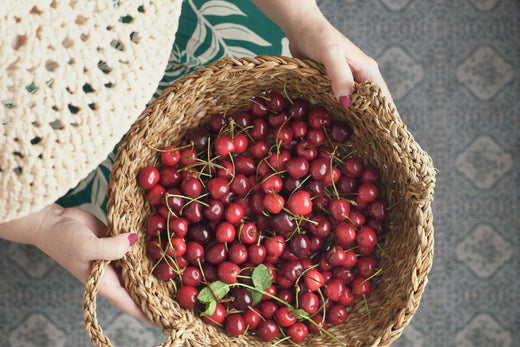Fresh cherries are a summer delight that many of us look forward to. But how do you know when cherries are truly fresh and ready to eat? Knowing what to look for can make a big difference in enjoying these juicy fruits at their best. In this article, we’ll share some simple tips to help you pick the freshest cherries every time.
When you're at the store or market, it can be tricky to tell which cherries are at their peak. You might wonder if the deep red ones are better, or if the firmness matters. Maybe you're unsure if the smell can tell you anything about their freshness. By understanding a few key indicators, you can confidently choose cherries that taste sweet and are good to eat.
Getting the best out of your cherries doesn't end with picking them. How you store them plays a crucial role in keeping them fresh for longer. We’ll also share some handy tips on how to store your cherries so they stay delicious. Whether you’re a cherry lover or new to enjoying this fruit, these tips will help you make the best choices for the freshest cherries.
Visual Clues to Identify Fresh Cherries
Fresh cherries look vibrant and appealing. The first thing to check is the color. Fresh cherries usually have a deep, rich color. Depending on the variety, this could be a dark red, bright red, or even a deep mahogany hue. Avoid cherries with dull or blotchy colors as they are likely older or not stored properly.
Take a good look at the stems, too. Fresh cherries will have green, flexible stems that are still firmly attached to the fruit. If the stems are brown, dry, or falling off easily, those cherries might not be as fresh as they should be. Checking the stems gives you a good clue about the cherry's freshness and how recently they were picked.
Check for blemishes or bruises as well. Fresh cherries should have smooth, unblemished skin. Wrinkled skin is a sign that the cherries have started to dehydrate and might not taste as good. Look for cherries that appear plump, juicy, and free from cracks or soft spots.
The Importance of Firmness and Texture
Firmness is a critical factor when it comes to picking fresh cherries. Gently squeeze a cherry between your fingers. It should feel firm but give slightly under pressure. If a cherry feels too hard, it might not be ripe yet. Conversely, if it feels too soft or mushy, it's likely overripe and may not taste as good.
Texture also plays a significant role in cherry freshness. Fresh cherries have a smooth, shiny surface. When you bite into a fresh cherry, it should have a good balance of firmness and juiciness. Overripe cherries tend to have a limp, watery texture that’s less enjoyable.
Remember, cherries will not continue to ripen after they are picked, unlike some other fruits. So, what you see and feel at the market is what you get. Make sure to select cherries that are at the right stage of ripeness to enjoy the best flavor and texture.
Smell and Taste Tests for Freshness
The smell and taste of cherries can also tell you a lot about their freshness. Fresh cherries should have a light, sweet fragrance. Take a moment to smell the cherries before buying them. If they have a subtle, fruity aroma, it's a good sign that they are fresh and ripe. A lack of scent or an off smell might indicate that the cherries are past their prime.
Taste is an excellent indicator of freshness, but since you can't always taste fruit before buying it, you’ll have to rely on other senses. If you get a chance to taste a cherry, it should burst with flavor. Fresh cherries are both sweet and slightly tart, offering a juicy and satisfying experience. If the cherry tastes bland or overly sour, it may not be fresh.
Keep in mind that different cherry varieties may have slightly different flavors, but the key is to look for a balanced taste that is enjoyable and refreshing. Trusting your taste buds and sense of smell can help ensure you get the freshest cherries.
Tips for Storing Cherries to Keep Them Fresh
Once you've picked out your fresh cherries, proper storage is crucial to maintain their quality. First, avoid washing cherries until you're ready to eat them. Washing before storage can cause moisture buildup, which leads to mold and spoilage.
Store unwashed cherries in the refrigerator to keep them fresh for as long as possible. Use a container with good ventilation, such as a colander or a bowl loosely covered with plastic wrap. This allows air to circulate, reducing the chance of mold growth.
For longer storage, you can freeze cherries. To do this, wash and pit the cherries, then spread them in a single layer on a baking sheet and freeze until solid. Transfer the frozen cherries to a sealed plastic bag or an airtight container.
Frozen cherries can be used in smoothies, desserts, or as a frozen snack. By storing cherries properly, you can enjoy their freshness and flavor even after their peak season.
Picking the Best Cherries at the Market
Knowing how to identify and store fresh cherries can make your cherry-eating experience so much better. By looking at visual cues, feeling for firmness, and even using your senses of smell and taste, you can ensure you're getting the best cherries available. Proper storage methods will then help maintain their freshness so you can enjoy them longer.
Conclusion
At Pure Organic Cherries, we take pride in providing you with premium cherries that are bursting with flavor and goodness. Our cherries are carefully grown to ensure you get the freshest product possible. Ready to savor the freshest cherries? Buy the best cherries online in NZ and discover the sweetest cherries, perfect for any occasion!



